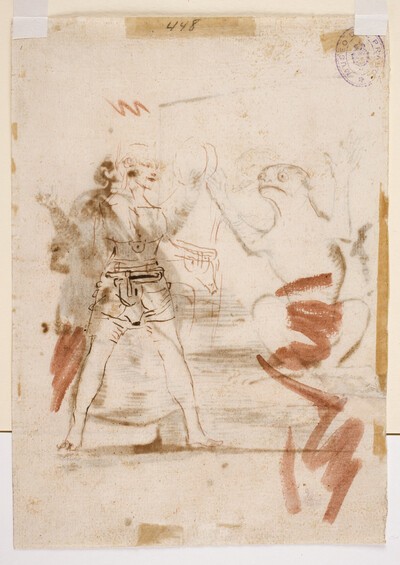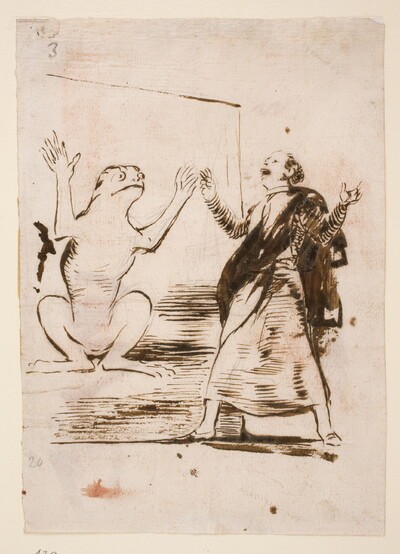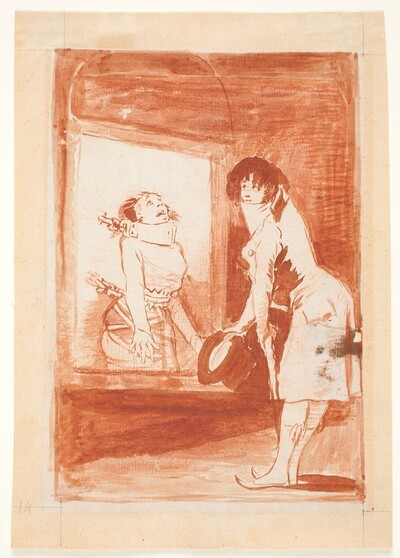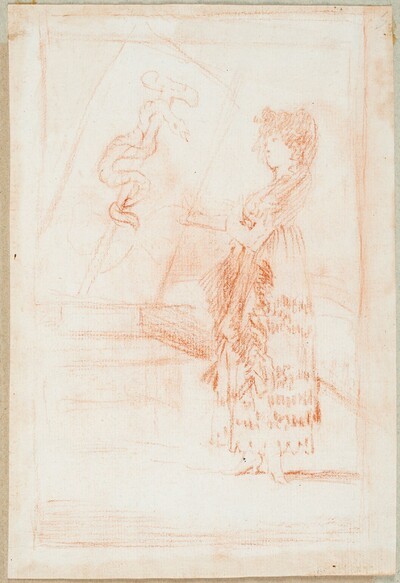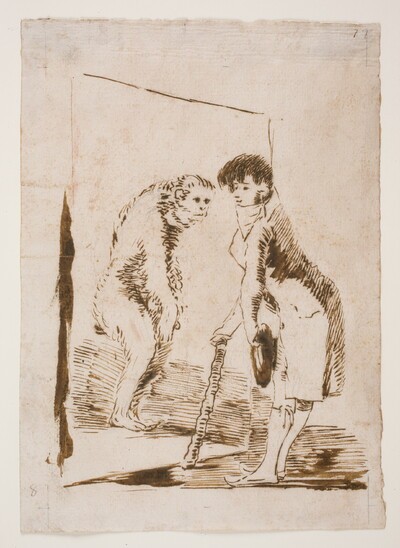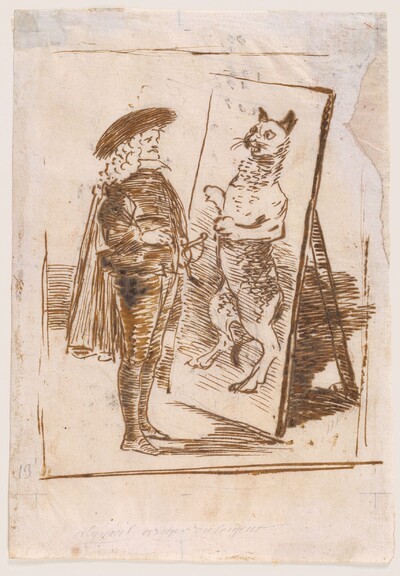- Cronología
- 1797 - 1798
- Ubicación
- The Prado National Museum. Madrid, Madrid, Spain
- Dimensiones
- 210 x 147 mm
- Técnica y soporte
- Reconocimiento de la autoría de Goya
- Documented work
- Titular
- El Prado National Museum
- Ficha: realización/revisión
- 20 Aug 2021 / 08 Jun 2023
- Inventario
- D4169
22 (in pencil, lower left)
Watermark. Lettering "YSIDRO / ESTEVAN".
By inheritance it passed in 1828 to Javier Goya, the painter's son, and in 1854 to Mariano Goya y Goicoechea, the artist's grandson. It was subsequently owned successively by Valentín Carderera (ca. 1861) and Mariano Carderera (ca. 1880). In 1886 it was acquired from Mariano Carderera by the Directorate General of Public Instruction and was assigned to the Prado Museum, where it is now located.
Between 1797 and 1798 Goya executed a series of seven drawings that were never engraved and which form a homogeneous group known as Magic Mirror. In all of them a figure, either a man or a woman, stands in front of a mirror in which he sees his image reflected in the form of an animal. Gassier states that these drawings are highly symbolic and represent the different types of human personalities.
Several scholars of Goya's work have analysed these drawings in depth, such as Folke Nordström, who in his Goya, Saturn and Melancholy. Studies in the Art of Goya, published in 1962, devoted an entire chapter to a detailed study of the compositions, giving each character a different type of temperament. Thus, the woman/snake would be the melancholic; the dandy/monkey the sanguine; the bailiff/cat the choleric; and the student/frog the phlegmatic. However, in 2000, the French Hispanist René Andioc contradicted Nordström in his article "Characters and faces of the late 18th century. El currutaco, according to Goya and the literature of his time", pointing out that the meaning of these drawings should be sought in the Aragonese artist's Madrid environment, as Pierre Gassier had already suggested in the catalogue Drawings by Goya of 1975, in which he pointed out that the symbolism of these drawings could come from the readings Goya regularly attended and the conversations he held in the gatherings he attended in Madrid. Gassier also suggested that these drawings could simply be a way of ridiculing certain of the artist's contemporary types, relating this attitude to that also found in some of the Caprices.
In this drawing, an elegantly dressed lady stands without looking in front of a large mirror in which her image is reflected in the form of a snake coiled around a scythe and shackled to it. Nordström, following López-Rey, claims that Goya was familiar with Bernard de Montfaucon's famous work L'Antiquité expliquée of 1719, in which several illustrations of Saturn appear as a half-naked man with two symbols: a scythe or sickle and a serpent coiled around a trunk. According to Nordström, the planet Saturn controls the melancholic temperament, which is considered to be characteristic of the female sex.
The drawing, mainly in pen, is characterised by its masterly and modern abbreviated technique.
-
El arte de GoyaMuseo de Arte Occidental de TokioTokyo1971from 16th 1971 to January 23th 1972. Exhibited also at the Kyoto Municipal Museum of Art, January 29th to March 15th 1972.
-
1972
-
Los dibujos de GoyaMuseo Provincial de ZaragozaZaragoza1978exhibition organized by Museo Provincial de Zaragoza, Ministerio de Cultura and Ayuntamiento de Zaragoza, exhibition guide written by Miguel Beltrán Lloris and Micaela Pérez Sáenz. October 1978cat. 45
-
Goya. Das Zeitalter der Revolucionen. Kunst um 1800 (1980 – 1981)Hamburger KunsthalleHamburg1980cat. 238
-
Madrid2019cat. 70
-
GoyaBasle2021
-
MadridMuseo del Prado1954n.268
-
Goya, Saturno y melancolía. Consideraciones sobre el arte de GoyaStockholmAlquimis & Wiksell1962pp. 94-115
-
Vie et ouvre de Francisco de GoyaParísOffice du livre1970p. 187, cat. 648
-
Dibujos de Goya, 2 volsBarcelonaNoguer1975p. 491, cat. 320
-
El mundo de Goya en sus dibujosMadridUrbión1979pp. 123-124
-
Goya, Das Zeitalter de Revolutionen. 1789-1830HamburgPrestel-Verlag Münche und Hamburger Kunsthalle1980p. 279
-
Calcografía Nacional y National Museum of Contemporary Arts de Seúl2000pp. 171-179
-
MadridMuseo Nacional del Prado2019p. 141

